Climate change impacts on fishing and aquaculture
There is evidence of a changing climate in Australia, with symptoms including increasing intensity, frequency and/or duration of extreme climate events (ECE), including flood, drought, heatwave and bushfires.
There is significant effort to try and understand likely causes, but for fishing and aquaculture in Australia, perhaps the most pressing need is to recognise that these changes are occurring, appreciate the associated risks and opportunities, and respond via execution of effective strategies to improve resilience and longer-term adaptation.
As explained in the FRDC Senate Inquiry submission on current and future impacts of climate change on marine fisheries and biodiversity, climate change affects fishing and aquaculture through three main physical attributes; temperature, currents, and water chemistry, as well as interactions between these. These are discussed further below.
Observed changes in temperature
Australia’s climate has warmed on average by 1.44 ± 0.24 °C since national records began in 1910. Most warming has occurred since 1950 with every decade since then being warmer than the one before. This warming trend has resulted in increased frequency of extreme heat events (Babcock et al. 2019). Australia’s southeast region has been identified as a global hotspot for ocean warming, with a rate of change faster than in 90 percent of the world’s oceans (Hobday & Pecl 2014).
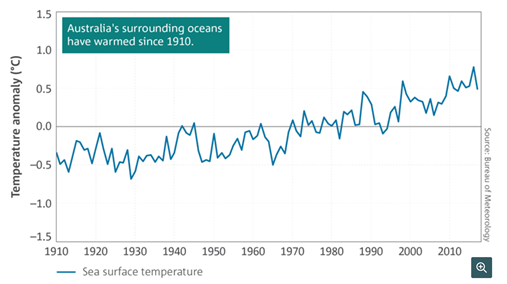
Figure 1 Anomalies in annual sea surface temperature in the Australian region. Anomalies are the departures from the 1961-1990 standard averaging period. Sea surface temperatures are for the Australian region (4-46°S and 94-174°E). Source: Bureau of Meteorology
Temperature increases are likely to affect many aspects of marine species’ life history and demography, including larval development, growth rate, onset of reproductive seasons, timing of migrations or other movements, geographical distribution (see https://www.redmap.org.au/ for citizen science tracking range extensions), and disease susceptibility (Pecl et al. 2009). All these changes have implications for marine and aquatic ecosystems, and the fishing and aquaculture communities that depend on them.
Changing oceanic temperatures have also contributed to increased frequency and intensity of marine heatwaves (MHW); defined as circumstances wherein seawater temperatures exceed a seasonally varying threshold (usually the 90th percentile) for at least five consecutive days (Hobday et al. 2016, Babcock et al. 2019) (Figure 2). The 2015 Tasman Sea MHW was the longest and most intense recorded and was associated with a number of nearshore ecosystem events including new disease outbreaks in farmed shellfish, mortality of wild abalone, and records of species normally associated with warmer ocean conditions (Oliver et al. 2017). A heatwave event on Australia’s west coast in 2011 resulted in mass mortality of fauna including a 99 percent mortality rate for Roe’s Abalone, and major reductions in recruitment of scallops, Western King Prawns, and Brown Tiger Prawns. Management responses included effort reductions and spatial and temporal closures.

Figure 2 Diagrammatic representation of a marine heatwave. Source: “All about marine heatwaves”, adapted from Hobday et al. (2016).
The abrupt and marked increases in temperature that define MHWs provide little opportunity for organisms to acclimate or adapt (Babcock et al. 2019). Consequently, MHWs are likely to have strong, and even irreversible, ecosystem and evolutionary impacts (Babcock et al. 2019). For example, Roe’s Abalone are yet to recover in the area affected by the 2011 MHW, and are still listed as a depleted stock in the Status of Australian Fish Stocks reports (Strain & Heldt 2021). Ecosystem impacts of MHWs are particularly serious when habitat-forming taxa such as kelp or coral reefs are affected (Babcock et al. 2019). MHWs have also been associated with increased occurrence of disease (Pecl et al. 2009), incidence of harmful algal blooms (HAB) increasing the risk of Paralytic Shellfish Poisoning (PSP). Lengthy fisheries closures have resulted.
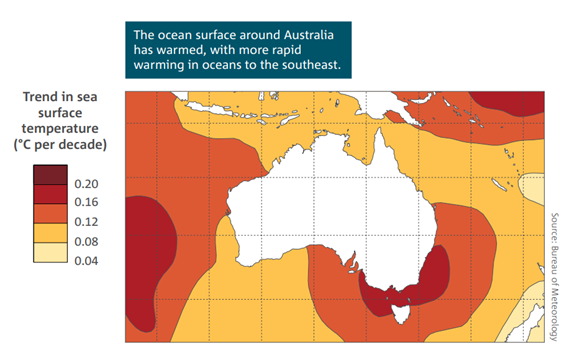
Figure 3 Trends in sea surface temperatures in the Australian region from 1950 to 2017 (data source: ERSST v5, www.esrl.noaa.gov/psd/).
Observed changes in water chemistry
Atmospheric carbon dioxide (CO2) levels are steadily increasing. The present atmospheric CO2 concentration has not been exceeded during the past 420,000 years, and likely not during the past 20 million years.
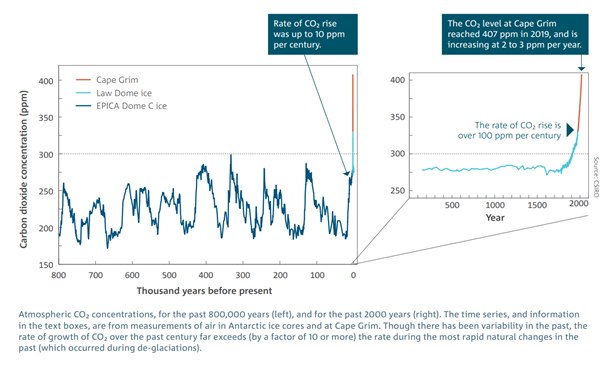
Figure 4 Atmospheric CO2 concentrations for the past 800,000 years (left) and for the past 2000 years (right), collected from air measurements in Antarctic ice cores and at Tasmania’s Cape Grim (source: CSIRO)
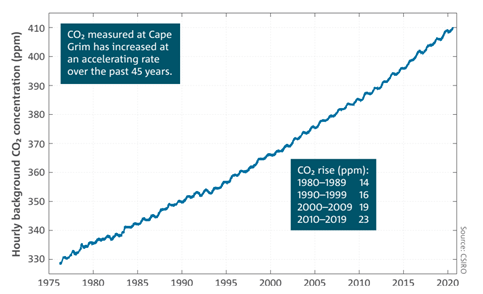
Figure 5 Background hourly clean-air CO2 measured at the Cape Grim Baseline Air Pollution Station in Tasmania, from 1976 - June 2020. Source: CSIRO
Observed increases in atmospheric CO2 levels are increasing dissolved CO2 levels in oceans, changing water chemistry and causing acidification. Oceans around Australia are acidifying 10 times faster than at any point in the last 300 million years. The impacts of ocean acidification for marine organisms are uncertain, but may include changes to species growth, physiology and reproduction, species composition, food web structure, nutrient availability and calcification rates for species that produce shells and exoskeletons from calcium carbonate (Pecl et al. 2014).
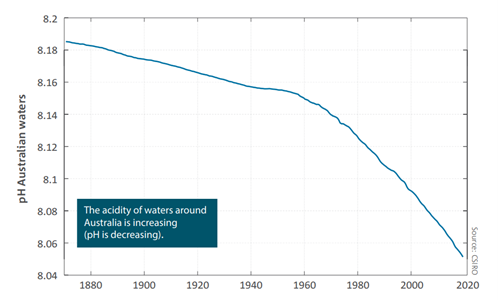
Figure 6 Average pH of surface waters around Australia, calculated from Integrated Marine Observing System and other programs, and extrapolation of atmospheric carbon dioxide concentration since the 1880s. Source: CSIRO.
Observed changes to currents
Ocean boundary currents shape Australia’s marine ecosystems by redistributing heat, freshwater, nutrients, and organisms themselves along the coastline (Evans et al. 2016). The three major currents structuring coastal Australian marine environments are:
- the East Australian Current (EAC), which flows south along the east coast and redistributes heat between the ocean and atmosphere, and between the tropics and mid-latitudes,
- The Indonesian Throughflow, which moves water between the Pacific and Indian Oceans, and
- The Leeuwin Current, which flows south off WA and redistributes warm Indian Ocean water into the mid-latitudes (Evans et al. 2016).
These currents, themselves primary architects of marine environments, are in turn shaped by global climate, particularly by a suite of key climate modes or oscillations including the El Nino Southern Oscillation (ENSO), Indian Ocean Dipole (IOD), and Southern Annular Mode (SAM). Changes to these modes are in turn changing key parameters of ocean boundary currents, with important consequences for marine ecosystems (Evans et al. 2016). Strengthening of the EAC’s poleward eddy transport has already caused MHWs, while weakening of the Indonesian Throughflow and Leeuwin Current will affect water exchange between inshore environments and the open oceans, in turn affecting nutrient supply and larval transport (Evans et al. 2016). Fished species that rely on cross-shelf larval transport (e.g. some lobsters) are likely to be negatively affected by these changes (Evans et al. 2016).
Predicting outcomes for Australian stocks and species
Net outcomes of climate change for Australian marine and aquatic species will be highly variable, with some species and fisheries emerging as “winners” and others becoming “losers” (Fulton 2011). The exact outcomes in any given ecological community will depend on complex interactions among species and species groups involving shifts in productivity low in the food web (e.g. plankton, algae), changes higher in the food web, and altered balance in competitive relationships (Fulton 2011). Both relatively early simulation studies (Fulton 2011) and more recent and sophisticated attempts (Pethybridge et al. 2020) suggest that, in general, species and ecosystems that are highly associated with the ocean floor (benthic, or demersal) are at greater risk than species that inhabit the water column (pelagic). Pelagic groups are generally more likely to benefit from changed water-column properties, can move more readily to find suitable conditions, and tend to be able to change their dietary composition in response to changing prey availability than are demersal species (Fulton 2011).
Overall, ecosystems typically occurring in regions characterised by mild temperatures (temperate regions) are probably at greater risk than those in the tropics (Pethybridge et al. 2020). Nonetheless, outcomes in tropical systems will still be highly context-dependent; for example among the various prawn species sought by the Northern Prawn Fishery, climate-induced changes in rainfall and turbidity could benefit some species and disadvantage others (Hobday et al. 2008). Some commercially and culturally important species in northern Australia are reliant on seagrasses, which are expected to undergo changes mediated by increased water temperatures, decreased solar radiation, changing rainfall and runoff patterns (including potential increases in agricultural runoff from rivers in Papua New Guinea, and increases in cyclone intensity (Stoeckl et al. 2017; Babcock et al. 2019)). Off south-eastern Australia, the three species that support the region’s most valuable fishers (Southern Rock Lobster, Blacklip Abalone, Greenlip Abalone) are likely to be sensitive to climate impacts, as are a number of other commercially and recreationally important species including Black Bream, King George Whiting, Commercial Scallop, School Prawns, and Blue Grenadier (Pecl et al. 2014a). Abalone and lobsters are vulnerable because adult life stages have little or no capacity to move when temperature or other parameters begin to exceed their physiological tolerances, and because other crucial stages in their life histories are strongly influenced by environmental parameters likely to shift with climate change (Pecl et al. 2009). Loss of kelp habitats caused by range-extending urchins is also a factor affecting likely sensitivity of abalone (Pecl et al. 2009).
Inland freshwater systems, already subject to multiple stressors, are highly exposed to climate-related impacts, particularly those relating to changes in rainfall patterns (Balcombe et al. 2011). As for marine systems, impacts will be unevenly distributed among species and ecosystems; Balcombe et al. (2011) predicted that, among the various habitats found in the Murray-Darling Basin, the highly modified systems of the southern Basin would experience the strongest negative impacts, with more northern systems being relatively less affected. However, more recent research has produced less sanguine results for northern basin systems, predicting that current stratification of temperature and oxygen, already extreme in these areas, will increase to the extent that only very small portions of the total stream area will have dissolved oxygen concentrations sufficient to support native fish. Nonetheless, there is a possibility that fishes inhabiting these areas may have behavioural and/or physiological adaptations to withstand extremes to some point. Additionally, in some areas native fish may be released from competitive or predatory pressure by introduced trout as physicochemical parameters exceed salmonid tolerances. Conversely, recent evidence also suggests that increasingly marginal conditions in many freshwater systems are likely to favour introduced European Carp, a hardy generalist with greater tolerance for poor water quality than most native species.
Socio-economic impacts
Just as the ecological effects of climate change will vary markedly across Australian marine ecosystems, so too will socio-economic impacts across fisheries and industry sectors. Some ecological changes will bring human benefits or are already doing so. For example, range extensions have created new commercial fishing opportunities for an octopus species (Ramos et al. 2014) and recreational fishing for Yellowtail Kingfish and Snapper that are becoming more prevalent in Tasmanian waters (Last et al. 2011; Pecl et al. 2019). Others will be profoundly negative, and indeed negative impacts are generally expected to predominate (Stoeckl et al. 2017; Maulu et al. 2021). For example, rising sea levels and loss of kelp beds off Tasmania pose risk to Indigenous cultural sites and resources, and reducing availability of culturally important maireener shells (Pecl et al. 2019). Urchin-mediated kelp loss is also affecting the productivity of the Southern Rock Lobster fishery.
Although socio-economic impacts of climate change clearly arise from biophysical change, predicting socio-economic impacts is more complex than mapping expected ecological changes onto the spatial boundaries, target species, and methods of current fisheries (Pecl et al. 2019; Ogier et al. 2016; Stoeckl et al. 2017). Rather, human responses to environmental change (e.g. changing commodity prices) will generate feedbacks that further alter both social and biophysical processes, creating a complex and dynamic system (Stoeckl et al. 2017). While understanding these complexities poses a considerable challenge, research in this area will be essential to help governments develop policies that aid the positive autonomous adaptation already underway among fishers and aquaculturists and maximise the number of viable adaptation pathways available in any given fishery (Pecl et al. 2019; Ogier et al. 2020; Stoeckl et al. 2017).
Observed changes in the finance sector
The insurance sector is an effective ‘canary in a coal mine’ due to its acute exposure to risk concentration via interconnected global systems, and possibility of increased frequency of multiple claims resulting in connection with a single event. An estimated $12–15 trillion in assets are estimated to be at risk from coastal flooding alone, according to the CRO Forum, and Australia’s bushfires in late 2019/early 2020 caused $4.4 billion in damage.
Several insurers are now incorporating climate-risk considerations in their product offerings and underwriting processes, while others have publicly committed to reducing their exposure to carbon-intensive industries by 2030 or 2040.
Fishing and aquaculture ventures are not immune to changes to insurability and/or premium levels, both through vulnerability to increasingly severe weather events, and, in the case of onshore assets, vulnerability to changing fire and flood risk profiles, and water availability. This will likely result in rising insurance premiums and reduced coverage, undermining availability and affordability of coverage, leading to underinsurance, and increased reliance on disaster relief from the public sector. This is also likely to disproportionately affect small and medium enterprises.
Like insurers, the banking sector is now clearly factoring climate risks into decision making. Fishing and aquaculture are highly exposed to climate change, and will consequently face both increased difficulties in obtaining credit, partly through investor concerns regarding increased capital risks. Perhaps surprisingly, these risks appear to have received relatively little formal analysis for Australian fishing and aquaculture, although studies are now emerging for the developing world (e.g. Kling et al. 2021).
As regions and industries most vulnerable to changing climate risk are identified finance markets are able and likely to rapidly reprice exposed assets, affecting insurers’ investment portfolios and their own market valuations negatively. These adjustments will likely cause insurers to re-evaluate their investment strategies as the economy transitions towards decarbonisation, particularly in carbon-intensive investments.
Mitigation, and adaptation
Human responses to climate change are often categorised as mitigation (measures intended to reduce the rate and/or magnitude of change) or adaptation (learning to live in a changing environment) (Pecl et al. 2014). Mitigation tends to be a focus at the national and international levels, while adaptation is a focus at regional, sectoral, and community levels (Pecl et al. 2014). Both mitigation and adaptation are important to Australian fishing and aquaculture; the industry has significant opportunities to profitably engage with effective mitigation measures at scale, including through commercial production of various marine algae, and by adopting various measures to reduce its carbon footprint in line with increasing consumer interest in carbon neutrality. Adaptation to present and future climate impacts is also a pressing priority for industry, researchers, and policy makers.
In a recent FRDC-funded review of risks to fishing and aquaculture, researchers provided the following 8 recommendations:
- Management priority, based on short-term sensitivity, should be given to: (i) northern invertebrate fisheries, and (ii) finfish fisheries with areas of regime change (e.g. Tasman Sea)
- Existing management strategies must be assessed in terms of their capacity to sustain long term ecological and resource management objectives.
- Flexible regulations and adaptive approaches are required to implement change as rapidly as needed in response to changing system state.
- Fisheries policy, management and assessment methods need to integrate the concept of regime shifts and extreme events for contextual management decision making.
- There needs to be greater recognition of non-static environmental conditions in fisheries operations and in the assessment and decision-making processes.
- A cross jurisdictional management of stocks is likely imperative.
- It will be increasingly necessary to acknowledge that not all fisheries and operators will have equal adaptive capacity.
- Integrated management needs to be central to fisheries management.
Subsequent FRDC-funded research is seeking to assess how well Commonwealth fisheries management approaches will cope with a changing climate and develop a methodology to help fisheries managers adapt their regulatory environment to climate impacts.
Other research has demonstrated that industry is already taking action autonomously to threats associated with a changing climate (as distinct from top-down, government-driven). For example, on Tasmania’s east coast, private actors have voluntarily reduced Total Allowable Catches (TACs), asked for increased HAB testing, invested substantially in real-time environmental intelligence and selective breeding (aquaculture), changed target species and enacted voluntary conservation measures for those species (commercial and recreational fishers), and altered site usage (recreational divers) (Pecl et al. 2019). In some cases, these actors have exerted bottom-up influence for adaptation through engagement in co-management processes (Pecl et al. 2019). All sectors undertaking autonomous climate adaptation off eastern Tasmania articulated a strong demand for information to guide their efforts.
While autonomous climate adaptation off eastern Tasmania is producing benefits for those involved (and indeed, is also producing public goods), adaptation measures by individual actors are not always possible or beneficial. Maladaptive actions are those that may produce benefits at the individual level, but be counterproductive in a broader sense (e.g. fishers increasing effort in response to stock declines). Furthermore, adaptive capacity at the individual and community level is a function of access to resources including wealth, income, and social networks, and also requires a supportive institutional framework (Pecl et al. 2019; Stoeckl et al. 2017). Consequently, marginalised stakeholders, particularly Indigenous people, are more likely to experience difficulties in adapting to climate-induced changes (Pecl et al. 2019; Stoeckl et al. 2017). Similarly, in commercial fisheries, larger operators with the freedom to respond to changed conditions may see substantial increases in the relative value of their operations under some climate scenario, while smaller operators are more likely to experience declines in value (Fulton, 2011).
For the reasons described above, autonomous adaptation by resource users, while often positive, is not a substitute for more coordinated, government-led adaptation approaches (Pecl et al. 2019). Coordinated and planned approaches should be best able to avoid mal-adaptations and are also most likely to ensure equitable distribution of public goods produced (Pecl et al. 2019). Adaptive capacity in at least some fishing communities appears to have declined through time (Tull et al. 2016), further emphasising the need for government-led capacity building and coordination. Furthermore, even the most ingenious adaptive efforts have limits, meaning that global efforts to mitigate climate impacts remain indispensable.
References
Babcock, RC, Bustamante, RH, Fulton, EA, Fulton, DJ, Haywood, MDE, Hobday, AJ, Kenyon, R, Matear, RJ, Plagányi, EE, Richardson, AJ, & Vanderklift, MA. (2019). Severe Continental-Scale Impacts of Climate Change Are Happening Now: Extreme Climate Events Impact Marine Habitat Forming Communities Along 45% of Australia’s Coast. Frontiers in Marine Science, 6. https://doi.org/10.3389/fmars.2019.00411
Balcombe, SR, Sheldon, F, Capon, SJ, Bond, NR, Hadwen, WL, Marsh, N, & Bernays, SJ. (2011). Climate-change threats to native fish in degraded rivers and floodplains of the Murray–Darling Basin, Australia. Marine and Freshwater Research, 62(9), 1099. https://doi.org/10.1071/MF11059
Fulton, EA. (2011). Interesting times: winners, losers, and system shifts under climate change around Australia. ICES Journal of Marine Science, 68(6), 1329–1342. https://doi.org/10.1093/icesjms/fsr032
Evans, K, Bax, NJ, & Smith, DC. (2016). Marine environment: Climate change. In: Australia state of the environment 2016, Australian Government Department of the Environment and Energy, Canberra, https://soe.environment.gov.au/theme/marine-environment/topic/2016/climate-change, DOI 10.4226/94/58b657ea7c296
Hobday, AJ, Alexander, LV, Perkins, SE, Smale, DA, Straub, SC, Oliver, ECJ, Benthuysen, JA, Burrows, MT, Donat, MG, Feng, M, Holbrook, NJ, Moore, PJ, Scannell, HA, Sen Gupta, A, & Wernberg, T. (2016). A hierarchical approach to defining marine heatwaves. Progress in Oceanography, 141, 227–238. https://doi.org/10.1016/j.pocean.2015.12.014
Hobday, AJ, & Pecl, GT. (2014). Identification of global marine hotspots: sentinels for change and vanguards for adaptation action. Reviews in Fish Biology and Fisheries, 24(2), 415–425. https://doi.org/10.1007/s11160-013-9326-6
Hobday, AJ, Poloczanska, ES, & Matear, RJ (eds.) (2008). Implications of Climate Change for Australian Fisheries and Aquaculture: A Preliminary Assessment, Report to the Department of Climate Change., Canberra, Australia.
Kling, G, Volz, U, Murinde, V, & Ayas, S. (2021). The impact of climate vulnerability on firms’ cost of capital and access to finance. World Development, 105131, https://doi.org/10.1016/j.worlddev.2020.105131
Last, PR, White, WT, Gledhill, DC, Hobday, AJ, Brown, R, Edgar, GJ, & Pecl, G. (2011). Long-term shifts in abundance and distribution of a temperate fish fauna: a response to climate change and fishing practices. Global Ecology and Biogeography, 20(1), 58–72. https://doi.org/10.1111/j.1466-8238.2010.00575.x
Maulu, S, Hasimuna, OJ, Haambiya, LH, Monde, C, Musuka, CG, Makorwa, TH., Munganga, BP, Phiri, KJ & Nsekanabo, JD. (2021). Climate change effects on aquaculture production: Sustainability implications, mitigation, and adaptations. Front. Sustain. Food Syst, 5:609097. https://doi.org/10.3389/fsufs.2021.609097
Ogier, E, Jennings, S, Fowler, A, Frusher, S, Gardner, C, Hamer, P, Hobday, AJ, Linanne, A, Mayfield, S, Mundy, C, Sullivan, A, Tuck, G, Ward, T, & Pecl, G. (2020). Responding to Climate Change: Participatory Evaluation of Adaptation Options for Key Marine Fisheries in Australia's South East. Frontiers in Marine Science, 7. https://doi.org/10.3389/fmars.2020.00097
Oliver, ECJ, Benthuysen, JA, Bindoff, NL, Hobday, AJ, Holbrook, NJ, Mundy, CN, & Perkins-Kirkpatrick, SE. (2017). The unprecedented 2015/16 Tasman Sea marine heatwave. Nature Communications, 8(1), 16101–16101. https://doi.org/10.1038/ncomms16101
Pecl, Gretta T, Ogier, Emily, Jennings, Sarah, van Putten, Ingrid, Crawford, Christine, Fogarty, Hannah, Frusher, Stewart, Hobday, Alistair J, Keane, John, Lee, Emma, MacLeod, Catriona, Mundy, Craig, Stuart-Smith, Jemina, & Tracey, Sean. (2019). Autonomous adaptation to climate-driven change in marine biodiversity in a global marine hotspot. Ambio, 48(12), 1498–1515. https://doi.org/10.1007/s13280-019-01186-x
Pecl, GT, Ward, TM, Doubleday, ZA, Clarke, S, Day, J, Dixon, C, Frusher, S, Gibbs, P, Hobday, AJ, Hutchinson, N, Jennings, S, Jones, K, Li, X, Spooner, D, & Stoklosa, R. (2014). Rapid assessment of fisheries species sensitivity to climate change. Climatic Change, 127(3), 505–520. https://doi.org/10.1007/s10584-014-1284-z
Pecl , G, Ward, T, Doubleday, Z, Clarke, S, Day, J, Dixon, C, Frusher, S, Gibbs, P, Hobday, A, Hutchinson, N, Jennings, S, Jones, K, Li, X, Spooner, D , & Stoklosa, R. (2009) Risk Assessment of Impacts of Climate Change for Key Marine Species in South East Australia, Part 1: Fisheries and Aquaculture Risk Assessment, FRDC Projects No 2009/070, Fisheries Aquaculture & Coasts (IMAS-FAC), Institute of Marine & Antarctic Studies (IMAS), University of Tasmania
Pethybridge, HR, Fulton, EA, Hobday, AJ, Blanchard, J, Bulman, CM, Butler, IR, Cheung, WWL, Dutra, LXC, Gorton, R, Hutton, T, Matear, R, Lozano-Montes, H, Plaganyi, EE, Villanueva, C, & Zhang, X. (2020). Contrasting Futures for Australia's Fisheries Stocks Under IPCC RCP8.5 Emissions - A Multi-Ecosystem Model Approach. Frontiers in Marine Science, 7. https://doi.org/10.3389/fmars.2020.577964
Ramos, JE, Pecl, GT, Moltschaniwskyj, NA, Strugnell, JM, León, RI, & Semmens, JM. (2014). Body size, growth and life span: implications for the polewards range shift of Octopus tetricus in south-eastern Australia. PloS One, 9(8), e103480–e103480. https://doi.org/10.1371/journal.pone.0103480
Stoeckl, N, Larson, S, Thomas, J, Hicks, C, Pascoe, S, & Marsh, H. (2017). Socioeconomic Impacts of Changes to Marine Fisheries and Aquaculture that are Brought About Through Climate Change. In Climate Change Impacts on Fisheries and Aquaculture (pp. 925–958). John Wiley & Sons, Ltd. https://doi.org/10.1002/9781119154051.ch28
Strain, L, and Heldt, K, 2021, Roe’s Abalone Haliotis roei, in Toby Piddocke, Crispian Ashby, Klaas Hartmann, Alex Hesp, Patrick Hone, Joanne Klemke, Stephen Mayfield, Anthony Roelofs, Thor Saunders, John Stewart, Brent Wise and James Woodhams (eds) 2021, Status of Australian fish stocks reports 2020, Fisheries Research and Development Corporation, Canberra.
Tull, M, Metcalf, S. J, & Gray, H. (2016). The economic and social impacts of environmental change on fishing towns and coastal communities: a historical case study of Geraldton, Western Australia. ICES Journal of Marine Science, 73(5), 1437–1446. https://doi.org/10.1093/icesjms/fsv196






